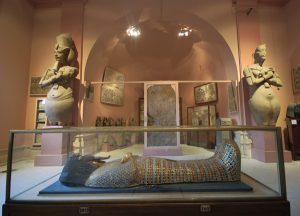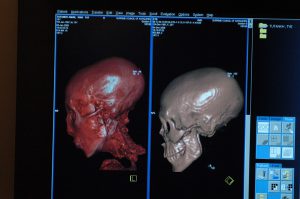
Abaddon
 26. 04. 2024
26. 04. 2024



 2
2
 17. 09. 2016
17. 09. 2016

Achnaton, the first Egyptian monotheistic pharaoh, has been employing Egyptologists for centuries. Has she finally found the mummy of the Egyptian Mummy Project?
The Valley of the Kings on the west bank of the Nile opposite the ancient city of Thebes is known as the final resting place of the pharaohs of the New Kingdom - the golden age of Egypt. In the valley there are 63 famous tombs, of which 26 belonged to the king. Beginning with the great Queen Hatshepsut, or perhaps her father Thutmos I, almost all the rulers of the eighteenth, nineteenth, and twentieth dynasties built their tombs in this quiet valley.
Only one king from this period, Amenhotep IV. (Akhenaten) chose another burial ground. Akhenaten refused to worship Amon, the chief god of his ancestors, and began to worship Aton. He left Thebes, then the main religious center of Egypt, and moved his government to central Egypt, to a place now known as El-Amarna. Near this new capital, he had prepared a place of his last rest.
Akhenaten's tomb is partly similar to that in the Valley of the Kings. It consists of several chambers and corridors carved deep into the limestone cliffs of the valley. It is decorated with unique scenes associated with the worship of the sun god Aton and images of the royal family. Akhenaten's beautiful wife, Queen Nefertiti, is the main object of the decoration of his tomb. Although Akhenaten's tomb at El-Amarne was never completely completed, there is no doubt that the king was buried in it.
After the death of Akhatenon, Egypt returned to the worship of the old gods, and the name and image of Akhatenon were erased from his monuments in an attempt to eradicate the memory of his heretical rule.
In January 1907, British archaeologist Edward Ayrton discovered another tomb in the Valley of the Kings. This tomb, designated KV55, is located south of the tomb of Ramzes IX. close to the famous tomb of Tutankhamun. KV55 is small in size, there are no inscriptions and decorations, but despite its simplicity, it has great historical value, because it is associated with the royal family from El-Amarna.
A staircase of 21 steps leads to the entrance of the tomb, which Ayrton found covered with limestone. Although the passage may have been open and then re-closed in ancient times, excavations revealed that the site was sealed like a burial ground with a jackal seal over nine arches, a traditional symbol of Egypt's enemies. Behind the entrance lay a corridor partially covered with pieces of limestone leading to a rectangular burial room containing a gilded and inlaid wooden coffin. Inside this coffin, a mummy was stored in poor condition, of which almost only the skeleton has been preserved. The lower three-quarters of the gilded mask in the coffin were missing, as was the decorative edging with the owner's name. The identity of the mummy in KV55 is one of the greatest mysteries of Egyptian science.
The content of the KV55 offers some clues to unravel the mystery of the mummy. Although the tomb has been severely damaged over the centuries by floods that recur regularly in the Valley of the Kings, many interesting artifacts have been found inside. Apart from the sarcophagus with a mysterious mummy, the most interesting object was the gilded wooden tomb, which was supposed to protect the sarcophagus of Queen Tiya, Akhenaten's mother. Originally, the name and image of Akhenaten were on the tomb, along with the image of the Queen, but they have not been preserved.
Other items from KV55 are small clay seals with the name of Tiya's husband, Amenhotep III. and Tutankhamun, who may have been her grandson. There were also vessels of stone, glass, and pottery, along with several pieces of jewelry named Tiye, Amenhotep III. and one of his daughters, Princess Sitamun. Also in the tomb were four magic bricks made of clay marked with the name of Akhenaten himself. In the alcove of the south wall of the burial chamber was a set of limestone canopes made for Akhenaten's second wife, Kiyu.
The decorative edging on the coffin may once have contained the key to the identity of the KV55 mummy. The great linguist Sir Alan Gardiner claimed that the inscriptions showed that the sarcophagus had been made for Akhenaten and that no one else could be buried in it. However, other scientists noticed that the inscriptions on the walls had been changed and that the one in the coffin did not have to be its original owner. French scientist Georges Daressy speculated that the tomb might belong to Queen Tiya and subsequently to Smenchkar, the mysterious successor of Akhenaten, who ruled Egypt for only a short time. Another possibility is that it belonged to Smenchkare at a time when he and Akhenaten ruled together.
The secret of the sarcophagus is even more mysterious, because part of it was stolen from the Egyptian Museum in Cairo. While the lid is mostly intact, the wood of the lower part has decomposed to such an extent that nothing has been preserved except the gold foil, glass and stone that lined its surface. The foil and tiling were transported from the Egyptian Museum in Cairo to the Museum of Egyptian Art in Munich, from where they recently returned to Cairo, but there are still rumors that pieces of gold foil from the coffin are still hidden in museums outside Egypt. I don't understand how a museum could buy an artifact that was stolen from another museum!
Gardiner's claim that the inscriptions on the sarcophagus referred only to Akhenaten convinced many scientists that the body of this mysterious king had been transported to Thebes and buried there after his original tomb in El Amarne had been desecrated. The bones belong to a man with an elongated skull. This feature is also characteristic of the artistic depictions of Akhenaten and his family, as well as the mummy of Tutankhamun, who was probably Akhenaten's son. In addition, the mummy KV55 has the same blood type as the golden king. Studies have shown that the remains of Amarna belonged to a close relative of Tutankhamun. Taken together, these clues lead to the conclusion that the mummy KV55 is probably Akhenaten.
Most forensic studies concluded that the skeleton belonged to a man who died at the age of 20, up to 35 years. Historical sources state that Akhenaten was well over 30 at the time of his death. Most Egyptian scholars are therefore inclined to believe that the mummy KV55 is Smenchkare, who may have been the older brother or even the father of Tutankhamun. However, identifying the mummy as Smenchkare brings other problems. We know very little about this king.
As part of the Egyptian Mummy Project, we decided to CT scan the KV55 skeleton in the hopes of finding new information that could help clarify the whole mystery. Our team studied several mummies and found many interesting things. Our last work led to the identification of the mummy of Queen Hatshepsut.
When we transferred the remains of KV55 out, it was the first time I saw them. It was immediately clear that the skull and other bones were in a very bad condition. Dr. Hani Abdel Rahman, Device Manager and Radiologist Dr. Ashraf Selim helped us interpret the results.
Our CT scan drew attention to Achnaton as a potential candidate. Our team was able to determine that mummy was older than expected at the time of death. Dr. Selim noted that in addition to mild scoliosis, spinal degenerative changes were associated with spine. He said that although it is difficult to determine the age of an individual by bone, the age at 60 is estimated. It is still close to the conclusion, but it is certainly tempting to think that Achnaton has finally found himself.
Akhenaten, Nefertiti and the Amarna period have enjoyed great attention in recent years. One of the main reasons for this interest was that we requested a loan of Nefertiti's head from the collection of the Egyptian Museum in Berlin. So far, the museum has not agreed to our request to transfer the head to Egypt for a period of three months as part of an exhibition to celebrate the anniversary of the opening of the Akhenaten Museum in Minya. We believe that people in Egypt have the right to see in person this beautiful work of art, which is an important part of their heritage and identity.
The magnificent artifacts in the newly renovated Amarna Hall of the Egyptian Museum in Cairo recall the achievements of this period. Queen Tiya's sarcophagus and the KV55 coffin lid adorn this room. The bust of Nefertiti from quartzite is perhaps even more beautiful than the limestone bust in Berlin. You can also see the gold foil and the bottom of the KV55 coffin.
The Valley of the Kings still has many secrets. Next year we will begin examining the DNA of the mummy KV55 along with those of Tutankhamun and others in the hope that this will help us to understand this period even better.
We will also embark on the first archaeological expeditions in the valley, which will be carried out by a purely Egyptian team. It is unbelievable that so far all excavations in the Valley of the Kings have been carried out by foreign experts. We are now working north of the tomb of Merenptah, son and successor of Ramzes II. I believe that the tomb of Ramses VIII can be located in this area. It is possible that at the time of publication of this article, you will hear reports of a significant discovery in the valley.
Still there are still uncovered royal tombs. For example, the tomb of Amenhotep I may lie in the Deir el-Bahri region. There are also many mummies that have never been identified. Remnants of Nefertiti, Tutankhamen's wife Ankhesenamun and many others are still waiting for their discovery or identification.
Sand and Stone from the Valley of the Kings hide treasures in the form of gold and in the form of information that can help us to reconstruct history. I hope that our new discoveries will lead us to a great story. I'm sure the Valley of the Kings will reveal some of our secrets. I feel it and I see it in my mind. Do not be ... I know it's true!